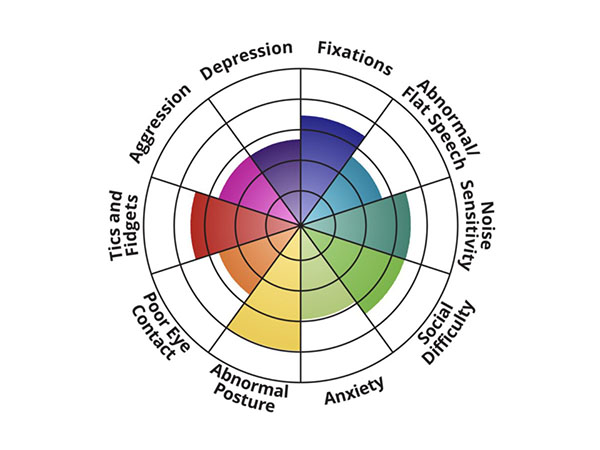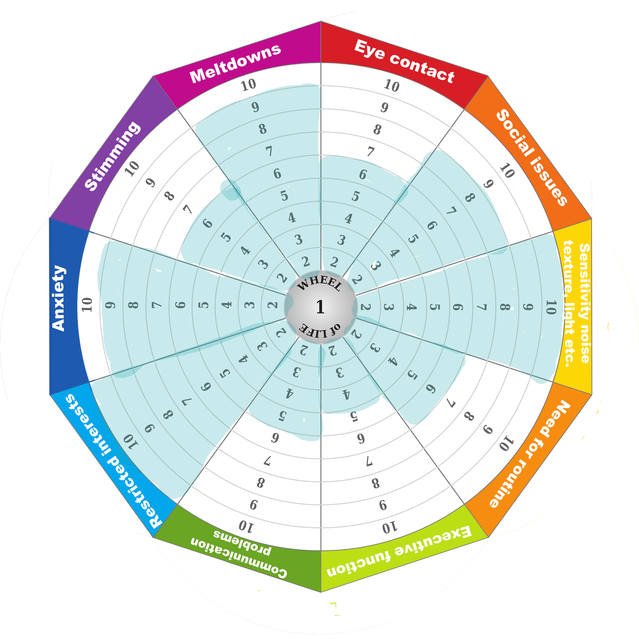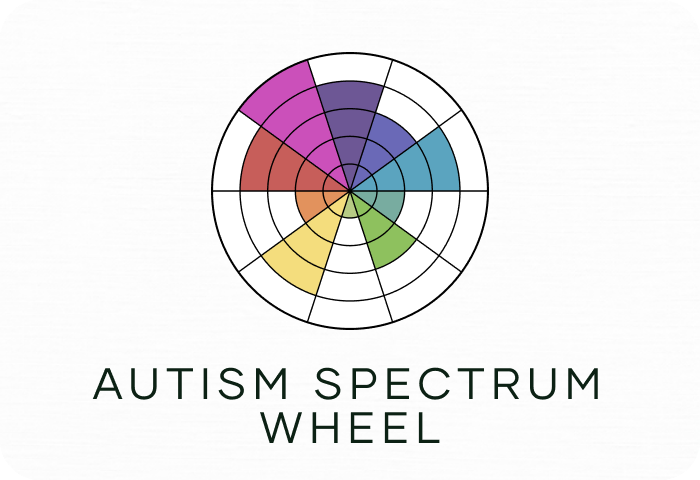Imagine having a tool that makes understanding Autism Spectrum Disorder (ASD) simpler and more comprehensive for you. The Autism Spectrum Disorder Wheel is just that—a visual guide designed to help you grasp the complexities of ASD with ease.
Whether you’re a parent, educator, or just curious, this wheel can transform how you perceive and engage with the spectrum. It breaks down overwhelming information into digestible, relatable segments, making it easier for you to connect and communicate with those affected by ASD.
Curious to learn more about how this wheel can change your perspective and approach? Keep reading, and discover how this tool can empower you to make a real difference.

Credit: ablelight.org
Understanding Autism Spectrum
The Autism Spectrum Disorder Wheel helps visualize the varied traits and challenges in autism. This tool provides insights into individual experiences, highlighting the diversity within the spectrum. Understanding these differences aids in fostering empathy and tailored support.
Understanding Autism Spectrum Autism Spectrum Disorder (ASD) is more than just a medical term; it represents a range of experiences and abilities. You might have heard of ASD through a friend, a family member, or even seen it depicted in media. But what does it truly mean to understand autism? It’s about recognizing the diversity within the spectrum and embracing the uniqueness of each individual. Understanding autism involves stepping beyond stereotypes and seeing the world through different lenses.
Defining Neurodiversity
Neurodiversity is a concept that celebrates the different ways brains function. Rather than viewing autism as a disorder, neurodiversity encourages you to see it as a natural variation in human wiring. Imagine a world where your unique cognitive style is valued. Wouldn’t it be empowering to know that your way of thinking is just another form of brilliance? By embracing neurodiversity, you’re acknowledging that there’s no single way to be ‘normal.’
Characteristics Of Autism
People with autism often experience the world in distinct ways. Some might have heightened senses, perceiving sounds or lights more intensely than you might. Others could have exceptional memory skills, recalling details with precision. However, autism isn’t just about differences in perception. It can also include challenges with communication and social interaction. You might notice someone with autism preferring routines or having specific interests. Think about your own preferences and habits. Everyone has quirks, right? Autism amplifies these characteristics, making each person on the spectrum uniquely interesting. So, how can you support someone with autism? Start by listening and observing. What do they enjoy? What makes them uncomfortable? Being present and empathetic can make a world of difference. Have you ever wondered how different life could be if you embraced neurodiversity in your daily interactions?

Credit: www.psychologytoday.com
The Autism Spectrum Disorder Wheel
The Autism Spectrum Disorder Wheel helps to visualize the range of autism symptoms. It shows different traits and challenges. This tool aids in understanding individual experiences with autism.
Autism Spectrum Disorder (ASD) is a complex condition that affects individuals differently. To better understand and support those with ASD, the Autism Spectrum Disorder Wheel offers a visual and practical tool. This wheel breaks down various aspects of ASD, providing insights that can be incredibly helpful for caregivers, educators, and individuals themselves.
What Is The Asd Wheel?
The ASD Wheel is a visual representation designed to help people grasp the diverse characteristics of Autism Spectrum Disorder. Imagine it as a colorful wheel, where each section highlights a different trait or challenge associated with ASD. It’s not just a diagnostic tool but a way to understand the broad spectrum of autism. This wheel allows you to see the variation in traits from one person to another. It’s a reminder that ASD is not a one-size-fits-all condition. Each section of the wheel can show areas of strength and difficulty, emphasizing the uniqueness of every individual.
Components Of The Wheel
The wheel consists of several key components. Each segment represents a different aspect of autism, such as communication, social interaction, and sensory processing. These components are crucial to understanding how ASD manifests in different people. For instance, communication might be a challenge for some, while others excel in visual learning. The sensory processing section might highlight sensitivity to noise or light, helping you tailor environments to individual needs. You can use these components to identify areas where support is needed. Think of it as a guide to create personalized strategies that enhance strengths and address challenges. How can this wheel change your perspective on autism? By recognizing the diversity within the spectrum, you can foster a more inclusive and supportive environment for those with ASD. What aspects of the wheel resonate with your experiences or observations? By reflecting on these questions, you can deepen your understanding and connection with individuals on the autism spectrum.
Navigating Neurodiversity
The Autism Spectrum Disorder Wheel helps in understanding the diverse traits of autism. It highlights strengths and challenges. This tool assists in visualizing the unique characteristics of each individual.
Navigating Neurodiversity within the Autism Spectrum Disorder Wheel is a journey that invites you to appreciate the rich tapestry of human uniqueness. The wheel is not just a tool; it’s a guide that helps us understand and celebrate the many ways autism presents itself. Embracing this concept is key to fostering a world where everyone feels valued and understood.
Embracing Differences
Embracing differences starts with recognizing the beauty in diverse perspectives. Consider how people with autism bring unique strengths to the table. They might excel in areas like attention to detail or innovative thinking. Think about your own interactions. Have you ever noticed how someone with autism can offer fresh insights into a problem? Their ability to think outside the box can be a game changer. You can start embracing these differences by actively listening. Be open to new ways of seeing the world. This mindset can enrich your life and relationships.
Promoting Inclusivity
Promoting inclusivity means creating spaces where everyone feels they belong. It’s not just about accommodating differences, but celebrating them. You might start by fostering an environment where neurodiverse individuals feel comfortable expressing themselves. This can be as simple as using clear and direct communication. Ask yourself: How inclusive is your workplace or community? Are there barriers that need addressing? Small changes can make a big impact. Inclusivity also involves educating others. Share your experiences and knowledge about neurodiversity. Encourage empathy and understanding in those around you. By promoting inclusivity, you contribute to a culture that values every individual’s unique contributions. What steps will you take today to make a difference?
Challenges And Misconceptions
Navigating the Autism Spectrum Disorder Wheel can be confusing due to common misconceptions. People often misunderstand the diverse challenges faced by individuals with autism. Simplifying communication and recognizing unique needs are essential for better understanding.
Autism Spectrum Disorder (ASD) is an intricate and multifaceted condition. Navigating the challenges and misconceptions surrounding ASD can be daunting for those affected and their families. Understanding these aspects is crucial for fostering empathy and creating a more inclusive society. This section delves into the common misunderstandings and barriers that individuals with ASD often face, providing you with insights to better understand and support them.
Common Misunderstandings
Many people mistakenly believe that all individuals with ASD exhibit the same behaviors and challenges. In reality, ASD is a spectrum, meaning it varies greatly from person to person. Some might have exceptional skills in specific areas, while others may struggle with daily tasks. Another widespread misconception is that people with ASD lack empathy. In truth, many individuals on the spectrum feel deeply for others but may express their emotions differently. These misunderstandings can lead to unfair judgments and hinder meaningful connections. Have you ever assumed someone with ASD is uninterested because they avoid eye contact? This is a common mistake. Many people with ASD find eye contact uncomfortable, but it doesn’t reflect their level of interest or engagement.
Social And Educational Barriers
Social interactions can be particularly challenging for those with ASD. Many individuals face difficulty interpreting social cues, which can lead to misunderstandings. This often results in feelings of isolation and loneliness. Educational settings pose additional hurdles. Traditional learning environments may not cater to the unique learning styles of students with ASD. Without the right support, they might struggle to keep up with their peers, impacting their self-esteem. Imagine a classroom where a student excels in math but struggles with reading. Tailored educational plans can help bridge these gaps, allowing students with ASD to thrive. It’s crucial for educators to recognize and address these diverse needs. Have you ever considered how small adjustments in social settings could make a big difference? Simple acts like providing clear instructions or using visual aids can significantly ease communication and understanding for those with ASD. By acknowledging these challenges and misconceptions, you contribute to a more inclusive environment. Recognizing the individuality of those with ASD and advocating for supportive measures can lead to positive changes in both social and educational contexts. How can you make a difference in your community today?
Support Strategies
The Autism Spectrum Disorder Wheel offers visual support strategies for better understanding and communication. It helps identify strengths and challenges. A useful tool for caregivers and educators in creating supportive environments.
Understanding and navigating Autism Spectrum Disorder (ASD) can be a journey filled with unique challenges and rewards. Implementing effective support strategies can significantly enhance the quality of life for individuals on the spectrum. These strategies not only help in addressing the symptoms but also empower individuals to reach their full potential. Whether you are a parent, caregiver, teacher, or friend, understanding and applying these strategies can make a meaningful difference. Let’s explore some practical approaches to support those with ASD.
Therapeutic Approaches
Therapeutic interventions are essential in supporting individuals with ASD. Common methods include speech therapy, occupational therapy, and behavioral therapy. Each of these therapies focuses on different aspects of development and can be tailored to meet individual needs. Speech therapy can help improve communication skills. For someone struggling to express themselves, this can open up new ways of interacting with the world. Occupational therapy often focuses on developing fine motor skills, which are crucial for daily activities. Behavioral therapies, such as Applied Behavior Analysis (ABA), are popular for encouraging positive behaviors. These therapies use rewards and consequences to shape behaviors effectively. Have you considered which approach might best suit the needs of your loved one?
Community Support Systems
Community support systems play a vital role in providing ongoing support. Schools often have specialized programs designed to support students with ASD. These programs can offer tailored educational plans, ensuring that each student receives the attention and resources they need to succeed. Local support groups can be a lifeline for families. Sharing experiences and strategies with others who understand the challenges can be incredibly reassuring. Have you reached out to your local community to see what support is available? Online forums and social media groups also provide a platform for connection. They can be a treasure trove of advice and encouragement. Engaging with these communities can help you feel less isolated and more empowered. Remember, the journey with ASD is unique to each individual. Exploring various support strategies can help you find the best fit for your situation. What steps will you take today to support someone with ASD in your life?

Credit: www.apricott.com
The Future Of Neurodiversity
Exploring the Autism Spectrum Disorder Wheel offers a fresh perspective on neurodiversity. This tool helps visualize the varied traits of autism, emphasizing individual strengths and challenges. Understanding neurodiversity through this approach enhances empathy and supports inclusive environments.
The future of neurodiversity is an exciting frontier, promising a society where differences are celebrated and understood. The Autism Spectrum Disorder Wheel is a tool that helps us see neurodiversity as a spectrum, highlighting the unique strengths and challenges each individual faces. As we move forward, embracing this diversity could lead to more inclusive communities, workplaces, and educational systems. Imagine a world where everyone feels valued and understood for who they are.
Advancements In Research
Recent research has brought new insights into autism, paving the way for better support and understanding. Scientists are uncovering how genetics and environment influence the brain, leading to personalized therapies. These advancements could mean more effective interventions, improving quality of life for those on the spectrum. What if we could tailor support to each individual’s needs? This is the promise of ongoing research.
Policy Changes And Advocacy
Policy changes play a crucial role in promoting neurodiversity. Governments and organizations are starting to recognize the rights of neurodivergent individuals, pushing for inclusivity. Advocacy groups are raising awareness, ensuring that voices are heard and respected. Consider the impact of a world where policies protect and empower those with autism. How can you support these changes in your community? By staying informed and involved, you can help shape a future that celebrates neurodiversity. Imagine the possibilities when everyone’s unique contributions are acknowledged and valued.
Frequently Asked Questions
What Is The Spectrum Wheel For Autism?
The spectrum wheel for autism visually represents various traits and characteristics associated with autism. It aids understanding of diverse autistic experiences, emphasizing individuality. This tool helps identify strengths and challenges, fostering better communication and support strategies for individuals on the autism spectrum.
What Are The 7 Spectrums Of Autism?
The seven autism spectrum types include classic autism, Asperger’s syndrome, Pervasive Developmental Disorder-Not Otherwise Specified (PDD-NOS), Rett syndrome, childhood disintegrative disorder, high-functioning autism, and atypical autism. Each type presents unique characteristics and challenges, requiring personalized support and understanding.
Why Is The Autism Wheel Replacing The Spectrum?
The autism wheel offers a more holistic view of autism traits. It highlights individual strengths and challenges. This approach promotes understanding beyond a linear spectrum, accommodating diverse experiences and characteristics. The wheel helps emphasize personal growth, support needs, and positive recognition of abilities.
What Is The Asd Symptom Wheel?
The ASD symptom wheel illustrates autism spectrum disorder symptoms, highlighting social, communication, and behavioral traits. It aids in understanding diverse ASD experiences and improving diagnosis. This tool helps identify specific challenges and strengths, facilitating tailored support and interventions for individuals on the spectrum.
Conclusion
Understanding the Autism Spectrum Disorder Wheel helps many people. It offers insight into varied experiences of autism. People learn about different challenges and strengths. The wheel promotes awareness and empathy. Parents, educators, and friends can use it effectively. It’s a tool for better communication.
It encourages acceptance and understanding. This is crucial for creating supportive environments. The wheel fosters community and connection. Each part of the wheel has its importance. It highlights unique aspects of autism. Everyone can benefit from this knowledge. It builds bridges, not barriers.
Embrace the diversity autism brings. Celebrate every individual’s journey.
